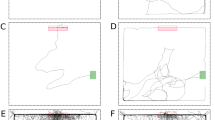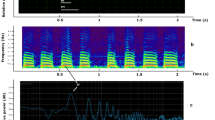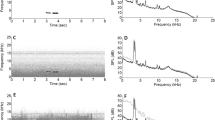Abstract
LARGE numbers of flying crickets can be attracted to outdoor loudspeakers broadcasting male calling songs1. Consequently we have been able to investigate the features of calling songs that are important for attraction. Previous investigators have used laboratory-maintained crickets in acoustical environments significantly different from outdoors2–7. Furthermore, they have studied thoroughly no more than one or two of the important signal parameters. We have studied outdoors the responses of free-flying mole crickets, Scapteriscus acletus, to synthetic calling songs systematically varied in these three parameters: carrier frequency, pulse rate and intensity., Mole crickets came in greatest numbers when we broadcast, at unnaturally high intensities, carrier frequencies and pulse rates like those of the natural song.
This is a preview of subscription content, access via your institution
Access options
Subscribe to this journal
Receive 51 print issues and online access
$199.00 per year
only $3.90 per issue
Buy this article
- Purchase on Springer Link
- Instant access to full article PDF
Prices may be subject to local taxes which are calculated during checkout
Similar content being viewed by others
References
Ulagaraj, S. M., and Walker, T. J., Science, 182, 1278 (1973).
Walker, T. J., Ann. ent. Soc. Am., 50, 626 (1957).
Loftus-Hills, J. J., Littlejohn, M. J., and Hill, K. G., Nature new Biol., 223, 184 (1971).
Schuvalov, V. F., and Popov, A. V., J. evol. Biochem. Physiol., 9, 152 (1973).
Katsaki, Y., and Suga, N., J. exp. Biol., 37, 279 (1960).
Nocke, H., J. comp. Physiol., 80, 141 (1972).
Dragsten, P. R., Webb, W. W., Paton, J. A., and Capranica, R. R., Science, 185, 55 (1974).
Ulagaraj, S. M., Environ. Entomol. (in the press).
Ulagaraj, S. M., Ann. ent. Soc Am., (in the press).
Busnel, R. G. (ed.), Acoustic q.havior of animals (Elsevier, New York, 1963).
Bennet-Clark, H. C., J. exp. Bieol., 52, 619 (1970).
Author information
Authors and Affiliations
Rights and permissions
About this article
Cite this article
ULAGARAJ, S., WALKER, T. Response of flying mole crickets to three parameters of synthetic songs broadcast outdoors. Nature 253, 530–532 (1975). https://doi.org/10.1038/253530a0
Received:
Revised:
Issue Date:
DOI: https://doi.org/10.1038/253530a0
This article is cited by
-
Targeting male mosquito mating behaviour for malaria control
Parasites & Vectors (2015)
-
Selective phonotaxis of female crickets under natural outdoor conditions
Journal of Comparative Physiology A (2014)
-
Calling behavior in bushcrickets of the genusPoecilimon with differing communication systems (Orthoptera: Tettigonioidea, Phaneropteridae)
Journal of Insect Behavior (1993)
-
Phonotaxis in femaleOrmia ochracea (Diptera: Tachinidae), a parasitoid of field crickets
Journal of Insect Behavior (1993)
-
Calling song recognition in the cricket Teleogryllus oceanicus: comparison of the effects of stimulus intensity and sound spectrum on selectivity for temporal pattern
Journal of Comparative Physiology A (1993)
Comments
By submitting a comment you agree to abide by our Terms and Community Guidelines. If you find something abusive or that does not comply with our terms or guidelines please flag it as inappropriate.



